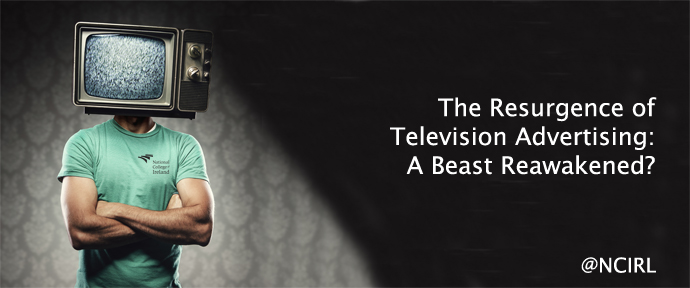Television advertising remains an important weapon in the arsenal of any marketer
One of the first things you learn in a marketing course is the importance of a measured, balanced marketing mix. Revision of what is supposed to be common sense is an important facet of learning any discipline - pros do things until they can't get them wrong.
This blog post will argue that television remains a primary communications channel for launching and supporting brands within the advertising landscape.
According to Green (2014), UK statistics provide a good snapshot of the role of television in the lives of consumers. In 2013, the average UK citizen watches four hours and 20 minutes of television every day – these are the highest viewing and growth levels on record (Green, 2014: 1).
TV, as a traditional competitive battlefield for brands, offers engagement, impact through sound, pictures and motion, the ability to reach all target groups quickly, and 'talkability' (Green, 2014) (Cools, 2014). In fact, the digitalisation of TV has had little effect on consumers’ preference to view live television, according to a study by the BBC (Green, 2014).
TV: The Primary Channel
Undeniably, the fragmentation of media consumption is happening at a rapid pace. However, all the signs indicate that television advertising’s position within the marketing mix remains intact.
For example, advertising revenue premiums gained for the programmes that do reach large audiences is increasing year-on-year (Brennan, 2013: 2) – a Superbowl advertisement costs a staggering $3.5 million, up 8% from the year before (Kim et al, 2013).
Although the overnight figures are significantly lower than for similar programmes in previous decades, these statistics are lacking. Once we add in the accumulated audience from on-demand and repeat channels across the rest of the week, there are significant gains across all boards, often bringing audiences up to 'pre-fragmentation' levels (Brennan, 2013).
Despite digitalisation, the combined share of our TV time taken up by on-demand experiences is less than 3% of the total share. Even when the delayed viewing of broadcast content is included, the share of total TV viewing taken up by live viewing to the broadcast schedules is well over 90% (Brennan, 2013: 4).
Why then does live advertising remain so lucrative? Television networks and schedulers know their audiences and know what programmes work best in different day parts, days of the week, and times of the year (Brennan, 2013). For example, advertisements during ITV's The X Factor are dominated by takeaway and food brands as the show is held on a weekend - the preferred time that UK citizens like to get takeaways (Brennan, 2013: 2).
Consumers plan and live their lives around TV schedule structures such as the news or major programming events like matches, season openers and the like. Therefore, the participation of consumers in live television viewing is still an important part of our cultural mindset.
TV: Brand-Building Myopia
Brands commonly ignore the effects of television advertising on long-term sales, preferring to concentrate instead on the impact of TV campaigns on short-term sales. Brands should recognise, however, the relationship between long-term consumer preferences, brand sympathy and ad awareness, and TV advertising (Modenbach and Wildner, 2013: 12). It is these aspects that ultimately reveal whether or not a consumer trusts a brand.
The importance of brand trust when it comes to consumer behaviour is borne out by Modenbach and Wildner’s (2013) analyses on loyal buyers and their importance for a brand's success in the marketplace. Buyer loyalty is also quite obviously linked closely to advertising, since studies show that those who gain loyal customers also invest more in advertising (Modenbach and Wildner, 2013: 8).
As Modenbach and Wildner (2013: 4) note, consumer purchasing decisions can be broken down into two primary categories: short-term and long-term effects. Advertising, price, and even promotions have a short-term effect on market share. These very factors have often been studied in the past and are included in most models. However, advertising on television networks also has a long-term effect on the success of a brand by instilling brand trust and loyalty, which are much more relevant to market share.
Conclusion
Is television advertising still an important part of a firm's marketing mix? In a nutshell, yes absolutely. So jump back on the bandwagon and put this reawakened beast back to work.
Want to learn more about postgraduate marketing courses in Dublin? Our part time course in Marketing and full time course in Marketing provides a comprehensive overview of the best-practices of many types of advertising tools. In NCI’s Marketing course, you’ll learn the ins and outs of strategy, brand management, digital marketing and integrated comms from marketing experts currently working in the area. If you enjoyed this piece you'll love our post on Facebook Atlas and the effect that it will have on digital marketing.
Questions? Feedback? Leave us a comment below. All commenters on NCI's blog get added to a raffle, to win a weekend away!















